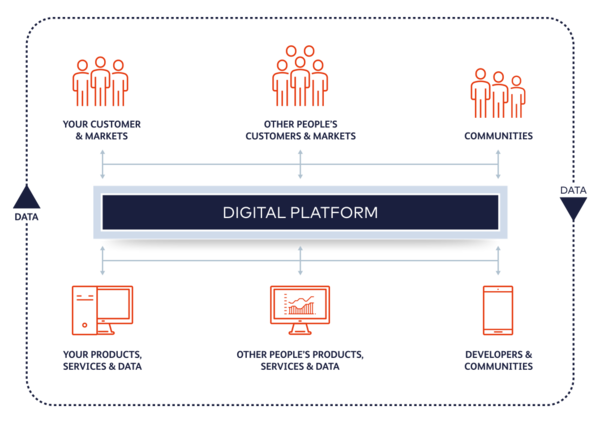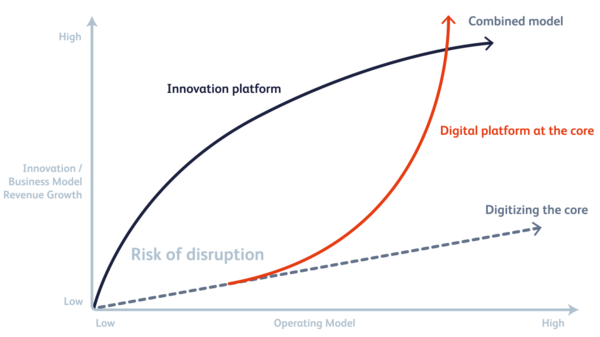
We are at an inflection point. Digital superpowers, unicorns and start-ups are continuously discovering new and more successful ways to win business. They are creating ever more powerful business models that challenge and disrupt established players in every market, sector and geography in ways not seen since the Industrial Revolution. Commentators will look back on this decade as one that shaped the following 50 years. Traditional companies tied to short-term financial goals are having to transform to compete and create a future for themselves. Whether that transformation is incredibly successful or fatal depends on the approach of management and the decisions they make today.
This extraordinary change has come in the form of the digital revolution, a revolution that some have used to create billion-dollar empires. In record-breaking time, they have harnessed the power of digital platforms to reinvent industry business models to win over new customers and digitally enable people to swap information, assets, opinions, services, content and ideas. And with each development in technology and every innovation come more start-ups, fully funded and eager to use their ideas to test new business models and overturn and disrupt traditional industries and strategies.
It’s clear that the world of business, like every other aspect of modern life, is changing quickly, but if a company has a business model that’s remained unchanged for decades, how are they going to adapt to thrive in this new digitized world? Start-ups have the luxury of beginning with a blank page (and often a blank cheque), able to create their own business models without legacy systems or staff that need to be reskilled. But for traditional companies, it can be a difficult journey.
We can shed some light on that journey, showing how you can introduce your company to business model reinvention through digital platforms, as well as harnessing their value and the many advantages they bring. All journeys will be different, but what remains the same across all organizations is the need for change, the importance of that change and the risks of doing nothing. Your company’s digital future will depend on it.
Many organizations have already embarked on their digital transformation journey. Our research shows that most efforts are centred on operating model optimization – using digital innovation to lower costs and improve service. Looking forward, real success in digital comes from ‘What you sell’ not ‘How you sell’, which means reinventing your business model.

Companies can learn from digital superpowers such as Amazon, Google and Microsoft about how to speed up the adoption of business model innovation. They drive new revenues and greater value from existing business by diversifying their portfolio of business models to include platforms.
Digital has many advantages, not least the ease with which products can be added and combined to provide a broader solution that’s far better at meeting customer needs and growing revenues than existing alternatives. Digital experience is a crucial part of the way the new digital solution is discovered, evaluated, accessed and consumed, whilst richer digital data at each point drives deeper customer insights, better decisions, more targeted selling and guides innovation. These new digital business models are all centered on digital platform business models.
Platforms form a marketplace that’s very different from the traditional fixed and linear value chains familiar to traditional companies. They generate value by bringing together and connecting the key actors of customers, producers and providers (ecosystem partners), facilitating interactions and transactions in a multi-sided model to create a network effect. Any one actor can play one or multiple roles in any scenario.
Today, asset-light platform businesses are perceived by investors as having much more sustainable sources of competitive advantage. Once the network effect starts to drive with volume there are lower costs of sales and operation, but then also negligible costs and cash required to scale. This makes platform-based businesses superbly profitable and allows them to re-invest far more in R&D and new product development. Investors see them as most likely to generate future growth, and this is reflected in much higher market valuations compared to both traditional asset intensive and services businesses.
BearingPoint Institute research found that companies who diversified and added digital platform-based business models into their mix improved their share price valuation by 65% in 2016 when compared to those who maintained a traditional mono-business model. Furthermore between 2011-2016 companies with hybrid models generated double the rate of growth at 8% per annum for this five year period versus 4% for traditional businesses, per annum for this five year period.
Despite strong empirical evidence, the Institute research highlighted that in Europe only 1% of established companies are actively developing a platform-based business model and an extensive partner ecosystem. Unfortunately, most business leaders are ambivalent towards this model due to issues such as risk, culture, monetization and time to ROI. Unfortunately, most business leaders are ambivalent towards this model since they are bound by short term financial performance and annual dividend playouts and are constrained by operational issues such as risk, culture, monetization and the impact on time to deliver ROI.
But business model change doesn’t need to be radical or high risk. There are many ways it can be an evolution that increases value and changes the relationship with customers.
Incorporating a digital platform model into the current business model requires a clear understanding of the synergies between old and new models. For example, Amazon’s acquisition of Whole Foods (ostensibly an asset-based traditional business model) was because Amazon knew it would unlock synergies that Whole Foods’ previous owners could not.

As suggested, there are a number of different pathways companies can take to realise the opportunities offered by the digital platform and unlock the synergies with their existing core business. Each results in a higher level of innovation and revenue growth.
Choosing the right pathway depends on business ambition and priorities, as well as the nature of the competition they face – both existing and emerging. It also depends on how they want to build (and protect) new capabilities whilst aligning stakeholders, skills and culture.
1. Innovation Platform
This stands alongside the existing business and is used to create new digital services and wrappers that can be sold separately. This model is relevant when companies are looking to introduce new digital offerings, embrace new technology or expand into adjacent industries.
The aim here is to use classic digital and lean start-up techniques to innovate and test new digital products to start building a differentiating partner ecosystem that will help with efficiencies and more cost-effectively address customer problems than existing alternatives. The process builds new capabilities and tests new platform-based products. Faster time to market and quick customer feedback are essential ingredients.
Companies facing digital disruption or rapid commoditization of traditional markets often adopt this approach to help re-build their competitive edge. If applied correctly, it gives businesses the advantages of a start-up and the ability to invent ideas: start small and scale up fast when required.
2. Digital Platform at the core
This more evolutionary path starts with digitizing a company’s operating model and business processes, reducing internal siloes through the orchestration of several operational environments to provide both immediate efficiency and customer experience gains. This allows the conversion of the core product to be sold as a service linked to specific customer outcomes. It also enables the expansion of core offerings to new digital services through innovation and the ecosystem.
This pathway is an evolutionary change. It is relevant when companies need immediate financial performance gains by improving efficiency, but is also a pathway to revenue growth and a reduced risk of disruption. The model isn’t appropriate if there’s an immediate threat of digital disruption or a need to radically re-think the business model.
3. Combined model
This is the typical path for digital transformation, which gradually adopts and integrates the two previous pathways. This pathway gives businesses the advantage of innovating fast for adjacent or new digital products that can be added to existing processes to compete quickly with disruption or become the disruptor themselves, while improving efficiency and growth at their core. This is good for thinking about hybrid business models where the innovation pathway is building synergies with the existing core business.